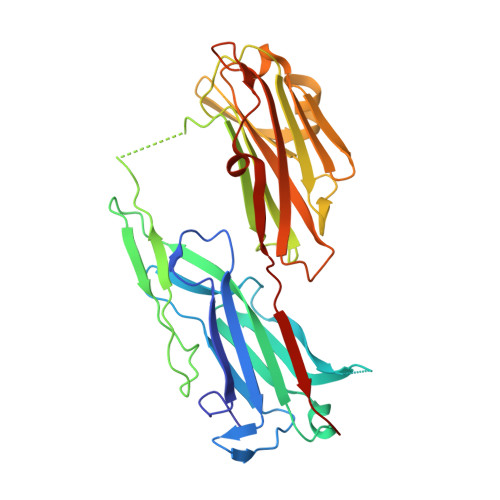Collagen adhesin-nanoparticle interaction impairs adhesin's ligand binding mechanism
Devi, A.S., Ogawa, Y., Shimoji, Y., Balakumar, S., Ponnuraj, K.(2012) Biochim Biophys Acta 1820: 819-828
- PubMed: 22538248
- DOI: https://doi.org/10.1016/j.bbagen.2012.04.006
- Primary Citation of Related Structures:
3V10 - PubMed Abstract:
Pathogenic bacteria specifically recognize extracellular matrix (ECM) molecules of the host (e.g. collagen, fibrinogen and fibronectin) through their surface proteins known as MSCRAMMs (Microbial Surface Components Recognizing Adhesive Matrix Molecules) and initiate colonization. On implantation, biomaterials easily get coated with these ECM molecules and the MSCRAMMs mediate bacterial adherence to biomaterials. With the rapid rise in antibiotic resistance, designing alternative strategies to reduce/eliminate bacterial colonization is absolutely essential. The Rhusiopathiae surface protein B (RspB) is a collagen-binding MSCRAMM of Erysipelothrix rhusiopathiae. It also binds to abiotic surfaces. The crystal structure of the collagen-binding region of RspB (rRspB31-348) reported here revealed that RspB also binds collagen by a unique ligand binding mechanism called "Collagen Hug" which is a common theme for collagen-binding MSCRAMMs of many Gram-positive bacteria. Here, we report the interaction studies between rRspB31-348 and silver nanoparticles using methods like gel shift assay, gel permeation chromatography and circular dichroism spectroscopy. The "Collagen Hug" mechanism was inhibited in the presence of silver nanoparticles as rRspB31-348 was unable to bind to collagen. The total loss of binding was likely because of rRspB31-348 and silver nanoparticle protein corona formation and not due to the loss of the structural integrity of rRspB31-348 on binding with nanoparticles as observed from circular dichroism experiments. Interaction of rRspB31-348 with silver nanoparticle impaired its ligand binding mechanism. Details of this inhibition mechanism may be useful for the development of antimicrobial materials and antiadhesion drugs.
Organizational Affiliation:
Centre of Advanced Study in Crystallography and Biophysics, University of Madras, Guindy Campus, Chennai-600 025, India.














